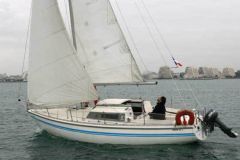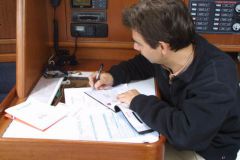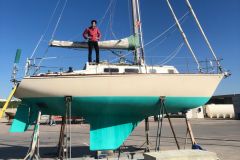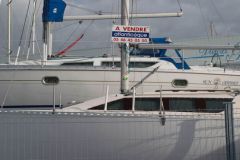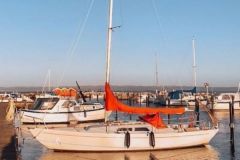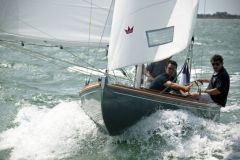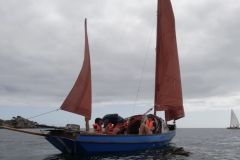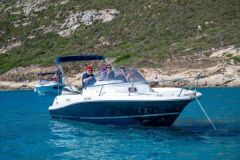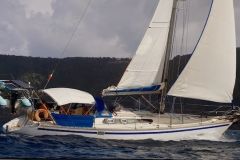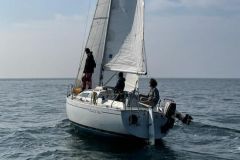A very livable sailboat
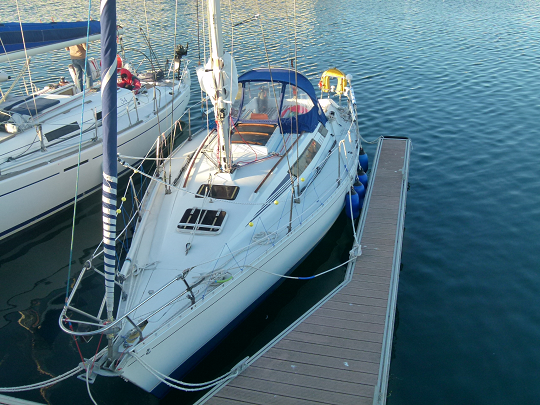
Very livable, the First 305 offers two cabins, a very spacious saloon and a sanitary area. It is true that with 3.25m of beam the interior volume is equivalent to a 32/33 feet.
Its interior design has nothing to do with the prototype from which it originated.
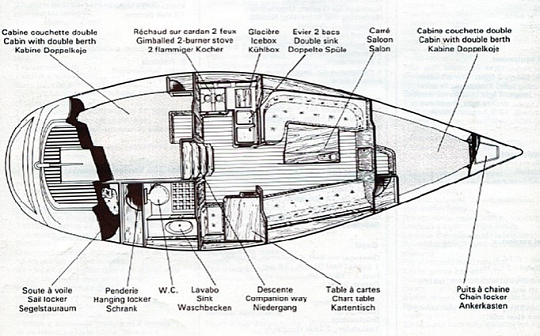
New boat for more navigation
After more than 10 years of sailing Ecume de Mer, Nadia, the happy owner of Enez Vey met in the harbor of Brest, feels the need for a little more comfort and the ability to sail further and longer. The boat being based in Brest, there is no shortage of destinations both to the North and to the South.
Change the boat, yes! But for which one?
The quick writing of a specification is as follows:
- 2 cabins
- Sanitary space
- Large square for 4/5 people
- Long cockpit
- Rear skirt
- Simple stranding
He directed his research towards a ballasted dinghy type boat, considered more stable than the integral dinghy and which, even when the daggerboard is blocked, keeps an embryo of appendage for manoeuvres.
After the sale of the Ecume de Mer and some research the First 305 DL is chosen.
Built in 1987, it is in perfect condition and its various maintenance logs attest to this. After a complete inspection, dry running and tests, the purchase is validated.
The pleasure of beaching
First great happiness: the stranding. "I'm a fan of small anchorages with little or no water and with this boat it's great" exclaims Nadia. "I pull up the daggerboard and the boat lands on its two rudders and its salmon. The draft at this time is 0.75 m! When dry, it is remarkably stable, you can move from bow to stern without difficulty and thanks to its ladder on the stern skirt, it is easy to go ashore (same thing for swimming!)"
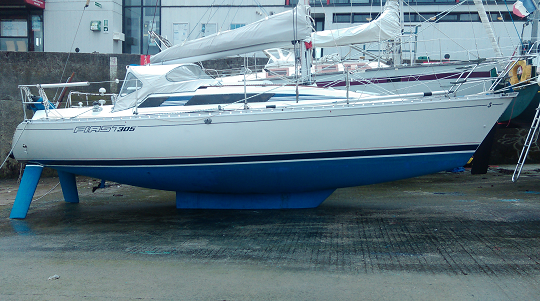
"As I wanted, the cockpit is enclosed and spacious enough for a full crew. The lack of a mid-cockpit clew makes it easy to maneuver and move around." adds Nadia.
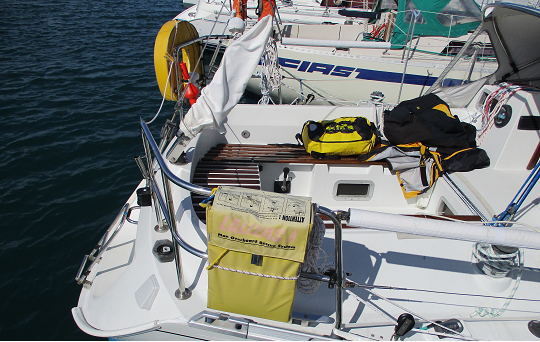
"Fully battened for the look the benches are comfortable and the orientation of the coamings allows a good position at the heel. The two rudders make it easy to steer and there is always a rudder in the water. The large starboard locker holds all our cruising gear, including spinnaker, jib and hawsers emphasizes the owner.
The boat is rigged as a sloop with a 19m² mainsail, a 31m² furling genoa and a 75m² symmetrical spinnaker. It also has a jib rigged on a removable forestay. A Volvo 18hp engine with propeller shaft completes the propulsion of the boat.
The daggerboard is operated with a worm screw (100 turns for low-euro daggerboard) and allows a draft of between 0.75m and 2.00m. "This important draft allows us to have a fairly steep boat and therefore to reduce the sail area for example upwind only from 18 knots apparent. It's a real comfort to sail!" says Nadia.
An interior design worthy of the greats.
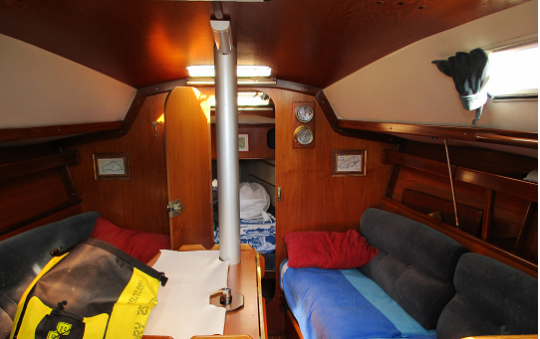
Its interior layout is very interesting, with a headroom of 1.85 m.
"When you go inside, you don't feel like you're in a 30-footer. You can sleep 4 people very comfortably in the 2 double cabins and occasionally 5 or 6 using the saloon's bunks.
For daily use, a double sink, a double gas stove and oven on gimbal and, real advantage, a fridge, equip the kitchen. A small drawback: the original fresh water reserve is only 80 liters and it is therefore preferable to double it.
As far as energy is concerned, we tend to use headlamps or LED lights on batteries to save energy. As a precaution we added a 70 A battery dedicated to the engine and kept the two original batteries in series (2 x 70 A) for the servitude, especially the fridge. It's for the butter!
The navigation corner is more than enough. VHF, Navtex, GPS, sounder repeater library, anemometer and wind vane, in short everything is there" concludes Nadia.

What about navigation?
It is a little heavy like many boats of this generation. When sailing, its 4 tons displacement can be felt. The DL version, with a very large salmon, does not have the hydrodynamics of the keelboat versions but it is a sailing choice.
"From 8/10 knots of wind, however, everything changes. The acceleration is clear and the boat reaches its critical speed very quickly. The ideal for this boat is to sail between 50° and 100° from the wind with 15/20 knots of wind and then it's great!" enthuses the navigator.
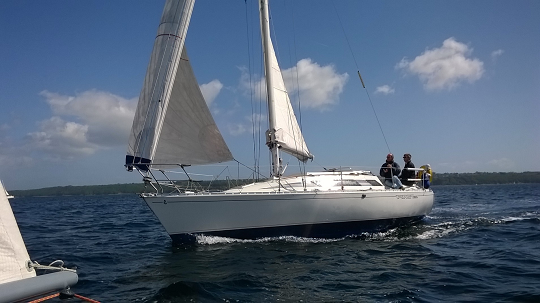
"We sail between the Chausey Islands and the Ile d'Yeu depending on the weather, a little, and our mood a lot. Our ability to run aground and thus find small anchorages makes this boat ideal for tidal areas like ours. For more comfort, we can choose ports like Sauzon in Belle Ile or Porz Kernoc'h in Ile de Batz, but always beached." explains Nadia.

"Depending on the nature of the sea bed, or if we are unsure of its nature, we can also prop up the boat, which takes the pressure off the rudders. This makes the boat more stable
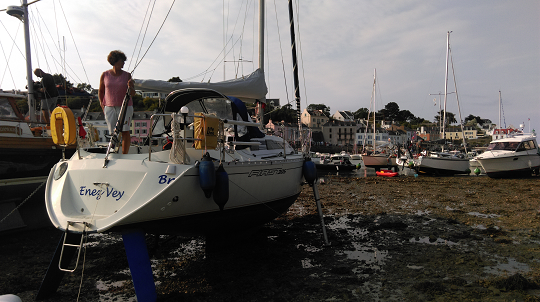
"In conclusion, I would say that we have found the boat that suits us. We feel safe, we can envisage 60 to 80 miles sailing without any problem even with a reduced crew, which is often the case. The comfort at anchor is total and even if this size of boat gives a comfort closer to a caravan than a yacht, it suits us very well" concludes Nadia



